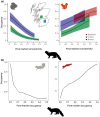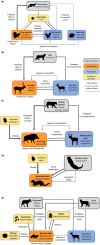Restoring vertebrate predator populations can provide landscape-scale biological control of established invasive vertebrates: Insights from pine marten recovery in Europe
- PMID: 35706099
- PMCID: PMC9542606
- DOI: 10.1111/gcb.16236
Restoring vertebrate predator populations can provide landscape-scale biological control of established invasive vertebrates: Insights from pine marten recovery in Europe
Abstract
Invasive species pose one of the greatest global threats to biodiversity. There has been a long history of importing coevolved natural enemies to act as biological control agents to try to suppress densities of invasive species, with historically limited success and frequent adverse impacts on native biodiversity. Our understanding of the processes and drivers of successful biological control has been focussed on invertebrates and is evidently limited and potentially ill-suited with respect to biological control of vertebrate populations. The restoration of native vertebrate predator populations provides a promising nature-based solution for slowing, halting, or even reversing the spread of some invasive vertebrates over spatial scales relevant to the management of wildlife populations. Here, we first review the growing literature and data from the pine marten-red and grey squirrel system in Europe. We synthesise a multi-decadal dataset to show that the recovery of a native predator has resulted in rapid, landscape-scale declines of an established invasive species. We then use the model system, predator-prey interaction theory, and examples from the literature to develop ecological theory relating to natural biological control in vertebrates and evolutionary processes in native-invasive predator-prey interactions. We find support for the hypotheses that evolutionary naivety of invasive species to native predators and lack of local refuges results in higher predation of naive compared to coevolved prey. We apply lessons learnt from the marten-squirrel model system to examine the plausibility of specific native predator solutions to some of the Earth's most devastating invasive vertebrates. Given the evidence, we conclude that depletion of vertebrate predator populations has increased ecosystem vulnerability to invasions and thus facilitated the spread of invasive species. Therefore, restoration of vertebrate predator populations is an underappreciated, fundamental, nature-based solution to the crisis of invasive species and should be a priority for vertebrate invasive species management globally.
Keywords: behavioural response; biological control; carnivore recovery; generalist predators; invasive naivety; invasive species; native predators; prey switching; refuge.
© 2022 The Authors. Global Change Biology published by John Wiley & Sons Ltd.
Figures





Similar articles
-
Habitat mediates coevolved but not novel species interactions.Proc Biol Sci. 2022 Jan 12;289(1966):20212338. doi: 10.1098/rspb.2021.2338. Epub 2022 Jan 12. Proc Biol Sci. 2022. PMID: 35016538 Free PMC article.
-
The enemy of my enemy is my friend: native pine marten recovery reverses the decline of the red squirrel by suppressing grey squirrel populations.Proc Biol Sci. 2018 Mar 14;285(1874):20172603. doi: 10.1098/rspb.2017.2603. Proc Biol Sci. 2018. PMID: 29514972 Free PMC article.
-
Native and invasive squirrels show different behavioural responses to scent of a shared native predator.R Soc Open Sci. 2020 Feb 26;7(2):191841. doi: 10.1098/rsos.191841. eCollection 2020 Feb. R Soc Open Sci. 2020. PMID: 32257340 Free PMC article.
-
Naïveté in novel ecological interactions: lessons from theory and experimental evidence.Biol Rev Camb Philos Soc. 2014 Nov;89(4):932-49. doi: 10.1111/brv.12087. Epub 2014 Feb 7. Biol Rev Camb Philos Soc. 2014. PMID: 25319946 Review.
-
A review of predation as a limiting factor for bird populations in mesopredator-rich landscapes: a case study of the UK.Biol Rev Camb Philos Soc. 2018 Nov;93(4):1915-1937. doi: 10.1111/brv.12426. Epub 2018 May 22. Biol Rev Camb Philos Soc. 2018. PMID: 29790246
Cited by
-
Core gut microbes Cloacibacterium and Aeromonas associated with different gastropod species could be persistently transmitted across multiple generations.Microbiome. 2023 Nov 29;11(1):267. doi: 10.1186/s40168-023-01700-0. Microbiome. 2023. PMID: 38017581 Free PMC article.
-
Red squirrels exhibit antipredator behavioural changes in response to a native predator, the pine marten.R Soc Open Sci. 2025 Jun 18;12(6):250661. doi: 10.1098/rsos.250661. eCollection 2025 Jun. R Soc Open Sci. 2025. PMID: 40535941 Free PMC article.
-
Parasite-Mediated Competition Limits Dominant Cervid Competitor.Ecol Lett. 2025 Jun;28(6):e70159. doi: 10.1111/ele.70159. Ecol Lett. 2025. PMID: 40556505 Free PMC article.
-
Abundance-mediated species interactions.Ecology. 2025 Jan;106(1):e4468. doi: 10.1002/ecy.4468. Epub 2024 Dec 5. Ecology. 2025. PMID: 39633243 Free PMC article.
References
-
- Anson, J. , & Dickman, C. R. (2012). Behavioral responses of native prey tofch disparate predators: naiveté and predator recognition. Oecologia, 171(2), 367–377. - PubMed
-
- Astorga, F. , Carver, S. , Almberg, E. S. , Sousa, G. R. , Wingfield, K. , Niedringhaus, K. D. , Van Wick, P. , Rossi, L. , Xie, Y. , Cross, P. , Angelone, S. , Gortázar, C. , & Escobar, L. E. (2018). International meeting on sarcoptic mange in wildlife, June 2018, Blacksburg, Virginia, USA. Parasites and Vectors, 11, 449. - PMC - PubMed
-
- Banks, P. B. , & Dickman, C. R. (2007). Alien predation and the effects of multiple levels of prey naivety. Trends in Ecology & Evolution, 22, 229–230. - PubMed
Publication types
MeSH terms
LinkOut - more resources
Full Text Sources

